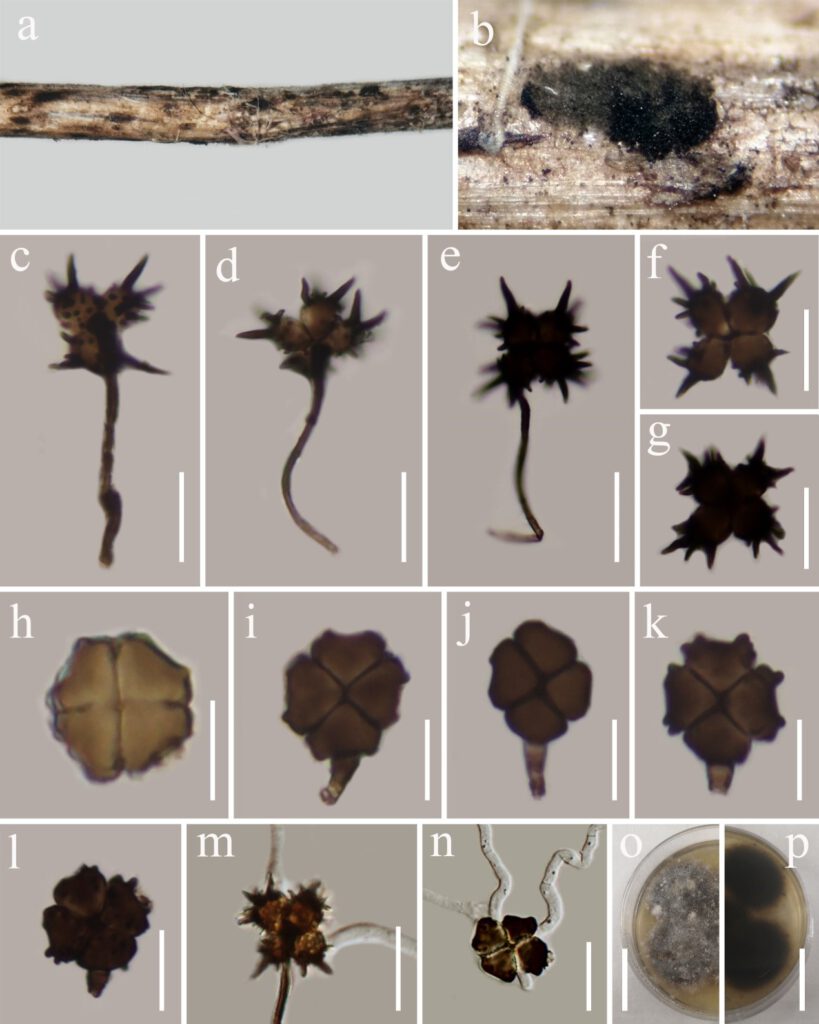Spegazzinia jinghaensis G.C. Ren & K.D. Hyde, sp. nov. Fig. 10
MycoBank number: MB; Index Fungorum number: IF; Facesoffungi number: FoF 10707;
Etymology ‒ The species epithet “jinghaensis” refers to the location where the species was collected.
Holotype ‒ KUN-HKAS 122787
Saprobic on dead woody twigs Myristica yunnanensis. Sexual morph: Undetermined. Asexual morph: Hyphomycetous. Sporodochia dark, dense, dry, powdery, velvety, 2–3 mm diameter. Conidiogenous cells basauxic, ampulate, 5–6 μm high × 4–5 μm wide (x̅ = 5.5 × 4.5 μm; n = 10), subspherical, hyaline to light brown. Conidiophores of α conidia up to 80–120 × 1.4–2.0 μm (x̅ = 100 × 1.7 μm, n = 10), erect or flexuous, unbranched, dark brown. Conidiophores of β conidia 3.5–8 × 2.5–3.5 μm (x̅ = 5.2 × 3 μm, n = 10) short, erect, unbranched, subhyaline or light brown. α conidia 16–20 × 15–19 μm (x̅ = 17.9 × 17.5 μm; n = 20), 4-celled, stellate-shaped, brown to dark brown, each cell globose to subglobose with dark brown warts on surface of the cells, conspicuous spines 3.5–8 × 1–2 μm (x̅ = 6 × 1.4 μm; n = 15), deeply constricted at the septa. β conida 12–16 × 13–17.5 μm (x̅ = 14.3 × 15 μm; n = 30), 4-celled, disc-shaped, quadrangular or subspherical, initially pale brown, becoming brown to dark brown at maturity, each cell turbinate, crossed septate, the crossed septate partly brown, smooth to verrucose, sometimes cells have raised verrucose around their edges, deeply constricted at the septa, flat from the side view, frequently with attached conidiogenous cells when splitting from the conidiophores.
Culture Characters ‒ Colonies on PDA, reaching 30–40 mm diam. at 14 days at room temperature (25–30 ℃), superficial, circular, surface rough, gray on the base, with sparse white mycelia on the surface; reverse black.
Known distribution ‒ dead woody twigs of Myristica yunnanensis (China).
Material examined ‒ China, Yunnan Province, Xishuangbanna Dai Autonomous Prefecture, Jinghong, Jingha (21°78.06’N, 101°05.61’E), on dead woody twigs of Myristica yunnanensis, 4 March 2020, G. C. Ren, JHD24 (KUN-HKAS 122787, holotype), ex-type culture, KUMCC 21-0495; JHD25 (KUN-HKAS 122878), living culture, KUMCC 21-0496.
Notes ‒ Spegazzinia jinghaensis is introduced as a new species based on its distinct morphology and the combined phylogeny of SSU, LSU, ITS, tef1-α dataset. In the phylogenetic analyses, Spegazzinia jinghaensis is distinct from extant species within this genus and closely related to S. bromeliacearum (URM 8084) and S. intermedia (CBS 249.89) without strong statistical supports (78 % ML, 1.00 PP, Fig. 1). Morphologically, Spegazzinia jinghaensis differs from S. bromeliacearum and S. intermedia in having both kinds of conidia (stellate-shaped conidia: 17.9 × 17.5 μm and disc-shaped conidia: 14.3 × 15 μm). In contrast, Spegazzinia bromeliacearum has globose conidia ((21–)26.5–28(–30.5) μm diam) with spines, and S. intermedia has disc-shaped conidia (18–28 μm diam) with dentate at the margin (Ellis 1976, Crous et al. 2019a).

Figure 10 ‒ Spegazzinia jinghaensis (KUN-HKAS 122787, holotype) a, b Fungal colonies on host surface. c–e Conidiophore of α conidia and α conidia. f, g α conidia. h–l β conidia. m, n Germinated conidia (m = α conidium, n = β conidium). m, n Culture characters on PDA. Scale bars: c–e = 20 μm, f, g = 15 μm, h–l = 10 μm, m, n = 20 μm, o, p = 30 mm.
